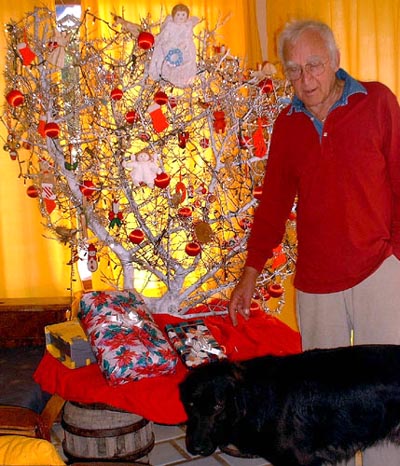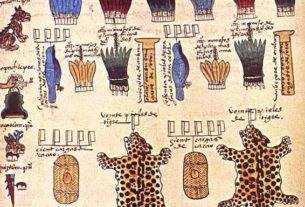Finding just the right tree for Christmas in Mexico was a challenge from the start. My Austrian husband had grown up with a father who worked on decorations for their tree for weeks in advance of Heiligen Abend. On that holy eve the traditional celebration and tree unveiling took place. Different colors of tissue paper were wrapped around particular candies; apples and cookies swung from scores of red strings knotted long in advance.
In high anticipation the children, dressed in their velvet dirndl dresses and lederhosen, tiptoed into the room, and stood in front of the tree to wait: first for the reading of the Christmas story according to Saint Luke, followed by the singing of Oh Tannenbaum and Stille Nacht. Christmas hugs and toasts of white wine for the grown-ups completed the ceremony.
Of course the children were aware of the presents lying beneath the tree. They knew their father probably had prepared that cozy hideaway far to the back beneath the tree, a place with soft cushions where they could later hide with a favorite toy. They might even be granted permission to spend the night under the fragrant giant.

My husband says that the most enduring memory, though wasn’t of the presents or the secret hideaway, but of the tree itself. It was a glorious sight, a noble pine, stretching up to the tall ceiling, and blazing with hundreds of real candles.
When we first came to Mexico, I couldn’t imagine any substitute for a real Christmas tree. Even 30 years ago, Canadian firs were available for a hefty price. Fully aware of the paradox, surrounded by palms and hibiscus, blessed with eternal sunshine, we still dreamed of and opted for a northern tree.
On Three Kings Day, the traditional date for tree dismantling, we dragged the fir outside, still trailing bits of tinsel, and debated how best to dispose of it. Refugio, our helper at the time, walked over and suggested, “Why don’t you plant it?”
You might think that a silly suggestion, but during a few short months in Mexico, we had been treated to more than one garden miracle. The bricklayers for our house had presented us with various dry, rootless branches or weedy clumps of green that we obediently planted into the clay and rock rubble of our first garden. We watched in amazement as these unlikely specimens transformed themselves in record time into frangipanis, plum trees, lemon grass tea, and other wondrous living things.
Refugio now stood waiting for our response. “Sí se prende, se prende!” Yes it will grow, he insisted.
Well, what did we have to lose? We chose a likely spot with northern exposure, dug a good hole and planted it. Then we watered, and watched and waited. Refugio repeated his assurances each time he saw me walking around the tree, hoping to spy the faintest hint of fresh green. I’m not certain how long it was before we finally gave up, but by that time even Refugio could see that this was one dead looking branch that intended to stay dead.
After a few years, my heart was no longer in purchasing the northern trees, on sale by Thanksgiving and dropping dry needles by mid-December. My own family tradition was also firmly opposed to the idea of an imitation tree. How we had scorned those shimmering, pink, aluminum imposters popping up in our neighborhood in the ‘fifties.
Nonetheless, a young divorcee, moving back to the states with her children, somehow convinced me to buy an imitation tree at her garage sale. “It’s greener and thicker than the real thing, a Cadillac of Christmas trees. You won’t regret it,” she assured me. At least she didn’t claim that, ” Se prende.”
Deaf to my better instincts, I let myself be convinced. I should have known better. For years thereafter I retrieved that tree from the bodega, unwound the sheets, and straightened the stiff wire branches, having to agree that it still was taller, thicker and greener than all the rest. Maybe the sad story of the family breakup made me hang on to the tree for as long as I did, not wanting to orphan it once again.
A few years ago I couldn’t face my Cadillac of a tree for one more holiday. It wasn’t hard finding a home for it, the new owners seeming happier than I’d ever been. But now, what to do for a tree?
As often, when faced with a household dilemma, I turned to Manuel. I knew that his home, along with most others in our barrio of Nestipac, proudly boasted a plastic tree at Christmas.
But Manuel began to describe for me the trees of his childhood. In those days the men of the family had gone up the mountain to select an appropriate specimen of the thorny copal, a tree that was then bedecked with simple, handmade decorations.
As Manuel recalled those early trees, I remembered noticing them during our first years in Mexico. Seen but dismissed by me as pitiful and poor, the trees couldn’t compare at that time to my northern notions of a proper Christmas tree.
“If you like, Señora, I could bring you a copal. You can decide then if you like it,” Manuel said.
A bristling grey-green copal, at first glance, isn’t a welcoming sight. At Manuel’s suggestion, though, we sprayed it white, set it up in the middle of an antique wagon wheel, and I began to decorate it. I noticed that little cuts in the tree exuded a thick sap with a lovely, exotic aroma. Manuel told me that small branches of copal are lit and waved from the church altar as incense.
As I unwrapped and hung the ornaments, many having graced our trees for almost 40 years, they seemed fresher than the year before. With no more real or plastic pine branches to get in the way, I could appreciate each individual piece, many of them lovingly purchased or handmade by my mother. Next came tiny white lights, a touch of tinsel and plenty of ice cycles. A local, hand-made angel topped the tree, gazing down at us, lopsided and bemused.
I wasn’t totally convinced until that evening, when we turned on the lights. Like no other tree I’d ever seen, the copal was magical, mystical, Austrian, American, but most of all, a truly Mexican Christmas tree.
Now, instead of dreading the Christmas tree tradition, I look forward to it. The humble copal transforms our living room but doesn’t overwhelm it. It knows it belongs.
Last year beloved Austrian visitors gave us a few real candles complete with special holders for the tree. These looked very much at home on Heiligen Abend as we read the Christmas story, sang the old carols, embraced and toasted yet another blessed year in Mexico.



